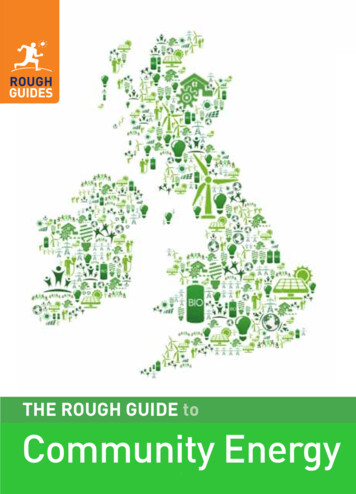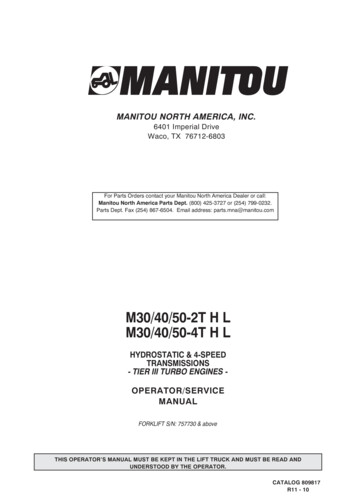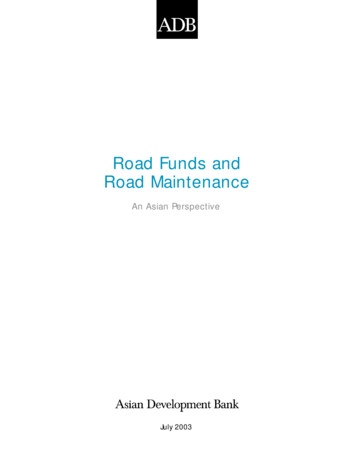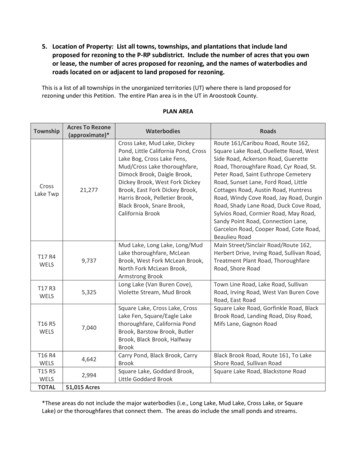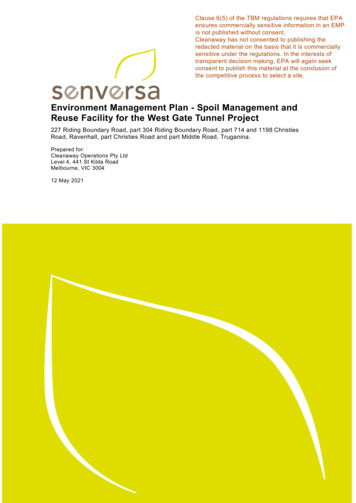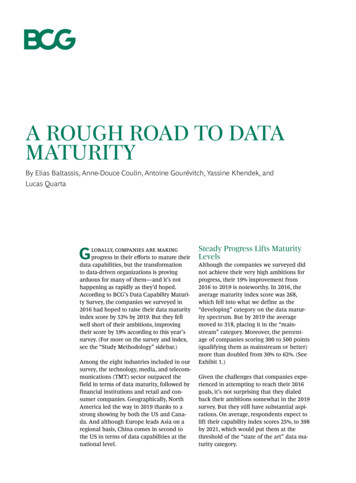
Transcription
A ROUGH ROAD TO DATAMATURITYBy Elias Baltassis, Anne-Douce Coulin, Antoine Gourévitch, Yassine Khendek, andLucas QuartaGSteady Progress Lifts MaturityLevelsAmong the eight industries included in oursurvey, the technology, media, and telecommunications (TMT) sector outpaced thefield in terms of data maturity, followed byfinancial institutions and retail and consumer companies. Geographically, NorthAmerica led the way in 2019 thanks to astrong showing by both the US and Canada. And although Europe leads Asia on aregional basis, China comes in second tothe US in terms of data capabilities at thenational level.Given the challenges that companies experienced in attempting to reach their 2016goals, it’s not surprising that they dialedback their ambitions somewhat in the 2019survey. But they still have substantial aspirations. On average, respondents expect tolift their capability index scores 25%, to 398by 2021, which would put them at thethreshold of the “state of the art” data maturity category.lobally, companies are makingprogress in their efforts to mature theirdata capabilities, but the transformationto data-driven organizations is provingarduous for many of them—and it’s nothappening as rapidly as they’d hoped.According to BCG’s Data Capability Maturity Survey, the companies we surveyed in2016 had hoped to raise their data maturityindex score by 53% by 2019. But they fellwell short of their ambitions, improvingtheir score by 19% according to this year’ssurvey. (For more on the survey and index,see the “Study Methodology” sidebar.)Although the companies we surveyed didnot achieve their very high ambitions forprogress, their 19% improvement from2016 to 2019 is noteworthy. In 2016, theaverage maturity index score was 268,which fell into what we define as the“developing” category on the data maturity spectrum. But by 2019 the averagemoved to 318, placing it in the “mainstream” category. Moreover, the percentage of companies scoring 300 to 500 points(qualifying them as mainstream or better)more than doubled from 30% to 62%. (SeeExhibit 1.)
STUDY METHODOLOGYAfter conducting our Data CapabilityMaturity Survey, we used the results tocreate a performance index. The indexestablishes benchmarks that helpcompanies more precisely assess thematurity of their data capabilities compared with that of their peers. Thisknowledge can help companies designbetter digital strategies to compete moreeffectively as data-driven organizations.The index is based on the seven datacapabilities in BCG’s Data CapabilitiesModel. (See the exhibit.)Across these seven capabilities, weweighted 19 dimensions and 55 criteriaand then created an aggregate scorefrom 100 to 500. That score placed eachcompany somewhere on the five-stagedata maturity spectrum: Lagging. Has made little to noprogress across the seven datacapabilities. Developing. Understands its datacapability challenges and has startedto work on them in earnest. Mainstream. Possesses average datacapabilities for its industry. State of the Art. Has several areas ofexcellence among the seven datacapabilities but may not managethem cohesively. Best Practice. Is advanced in all dimensions of data-capability buildingand manages them cohesively.The survey results included in this article are just a sampling of the data wecollected. The full data has been reserved for internal BCG analysis andclient cases.BCG’s Comprehensive Data Capabilities ModelExamples of key issues to addressChange managementVisionUsecasesAnalyticssetupData governanceData infrastructureData ecosystem Why are we interested in data? What are we trying to achieve? Do we want to improve our current practices or undertake aradical transformation? Which are the main macro use cases? How much value do weexpect from each? Do we have the right end-to-end ownership and accountabilityfor our use cases? Do we have the right talent pool? Have we implemented theright analytics functions? Do we have a thorough analytics process, leading to concreteresults? Do we have a data management organization in place? Have we launched basic data hygiene actions (e.g., definingquality and key quality indicators)? Is our infrastructure suitable to our vision and future use cases(e.g., technologies and operating model)? Is it end to end—from modeling to industrialization? Do we understand and leverage the data ecosystem around us? How should we manage the ecosystem? What role should weplay in it? How do we handle change management from legacy to adata-driven company? Do we leverage new ways of working?Source: BCG.Boston Consulting Group A Rough Road to Data Maturity 2
Exhibit 1 Distribution of Companies by Data Maturity2016 survey (%)LaggingDevelopingMainstream(100 points)(200 points)(300 points)11State of the artBest practice(400 points)5927(500 points)3Average maturityindex score (268)2019 survey (%)LaggingDevelopingMainstream(100 points)(200 points)(300 points)4State of the artBest practice(400 points)3451(500 points)11Average maturityindex score (318)Sources: BCG Data Capability Maturity (DACAMA) Surveys, 2016 and 2019; BCG analysis.All Data Capabilities Improvedin the New SurveyAs part of our analysis to better understand strengths and weaknesses, we examined how companies have performedacross seven data capabilities: vision, usecases, analytics setup, data governance,data infrastructure, data ecosystems, andchange management. Back in 2016, thestrongest data capability among thosesurveyed was vision, which helped to seta solid foundation for data strategy. Yet,somewhat surprisingly given this strength,companies also said they struggled to applythat vision and develop concrete use cases.Data infrastructure and data ecosystemswere even weaker, probably because theyrequire more enterprisewide transformation than developing a vision and identifying use cases.Since 2016, all capabilities have improved.(See Exhibit 2.) But the 2019 results revealsome surprises. For example, sdata infrastructure and data ecosystems improveddramatically—although they grew from acomparatively low base, which made thosebig gains easier to achieve. Driving thegrowth in these capabilities was the vastimprovement in open-source technologiesand the increasing number of AnalyticsBoston Consulting Group A Rough Road to Data Maturity as-a-Service (AaaS) and Platform-as-aService (PaaS) solutions.Less obvious in these results, but very telling, is the relative underperformance ofanalytics setup (in other words, creatingvalue and having the right analytics processes and people in place), which hasgone from the second most developed capability to one of the least mature. Thatcame despite very high ambitions. On average, companies had hoped to raise the maturity score for analytics setup from 293 to435—a dramatic 48% increase. Instead, itrose just 7% to 314.This trend was consistent across regions,industries, and company size, suggestingthat most companies are struggling withorganizational issues as they try to deliveron their business strategy (such as aligningvarious stakeholders). Interestingly, theyare having trouble with their analytics setup despite strong support from top management.In the face of these challenges, companieshave pulled backed on their 2021 ambitions for analytics setup and are aiming fora maturity score of 397. Although that’s farbelow the ambition they set in 2016, it3
Exhibit 2 Average Data Maturity Index Score by Data 259251213VisionUsecases2016 data maturity indexAnalyticssetupDatagovernance2019 data maturity ent1Growth (%)Sources: BCG Data Capability Maturity (DACAMA) Surveys, 2016 and 2019; BCG analysis.Note: The maximum number of maturity index points is 500, indicating best practice.1Change management is a new dimension introduced in BCG’s latest data capabilities framework; hence, it was not evaluated in 2016.would still amount to a 26% increase overtheir actual 2019 score.In fact, the companies in the survey recalibrated their 2021 ambitions across theboard. In all cases—except data ecosystems—their 2021 maturity score targets arebelow their 2019 targets.We found that, despite the many challenges that these organizations face, state-ofthe-art companies tend to mature all sevendata capabilities consistently and cohesively, thus maximizing the value of their data.For example, the analytics setup and dataecosystems of these companies are bothmore than 40% more mature than the restof the market. This creates significant competitive advantages.TMT Leads Industries in DataMaturityWe also took a close look at the maturityof data capabilities across industries. (SeeExhibit 3.) All industries have improvedtheir data maturity from 2016 to 2019 butat varying rates. TMT continues to lead indata maturity and improved its index scoreby 15%, but energy and industrial goodsdemonstrated the highest upswing, possibly driven by the growth of Internet ofBoston Consulting Group A Rough Road to Data Maturity Things (IoT) data in those sectors. Unlikethe 2016 survey, which found that midsizecompanies had more mature data capabilities than small and large companies, the2019 survey shows that company sizemakes virtually no difference in data capability maturity.It’s no coincidence that leading industriesfocus on improving each of the seven datacapabilities. Indeed, TMT and financial institutions, the first and second most mature industries, scored above average in allseven capabilities. Meanwhile, industrialgoods, transport and logistics, health care,energy, and the public sector all scoredbelow average for most or all the components.This tells us that a company in any of theindustries in our survey that is lookingto advance needs a high level of maturityacross all capabilities. That finding is inline with what we learned about individual state-of-the-art companies. Being verygood at just a few capabilities is notenough. The silver lining, particularly forenergy and the public sector, is that theirindustries have so few advanced playersthat investing in these capabilities couldgive them a pronounced competitiveadvantage.4
Exhibit 3 Average Data Maturity Index Score by IndustryGrowth (%)288TMT277Financial institutions269Retail and consumer packaged goods257Industrial goods268Health carePublic sector22116319192016 data maturity index23311193101628725715320315261Transport and logisticsEnergy3322793092019 data maturity indexSources: BCG Data Capability Maturity (DACAMA) Surveys, 2016 and 2019; BCG analysis.Note: The maximum number of maturity index points is 500, indicating best practice.North America Continues toLead Among RegionsAs part of our analysis, we also examineddata capability maturity across regions. Allregions have developed since 2016, and today most have similar maturity levels. Butthey are evolving at different rates. WhileNorth America continues to lead, Europeand Asia have accelerated their growth toclose the gap. Both those regions have increased their maturity about 50% fasterthan North America. Looking forward, allthree regions are targeting 25% growth by2021.When looking at individual countries, amore complex landscape emerges. (To simplify the process of ranking and comparingcountries, we condensed the country rankings to “trailing,” “work in progress,” and“advanced.”) Although the US marginallyleads in data maturity, China has the highest concentration of companies with advanced maturity. Among the top eightcountries, Japan has a very high percentage of companies with a work-in-progressdata capability (79%) and has relativelyfew advanced and trailing companies.(See Exhibit 4.)Looking forward, China and India hope toovertake the US in data maturity by 2021.Boston Consulting Group A Rough Road to Data Maturity India is the most ambitious, aspiring toleapfrog its competitors and move fromnumber 12 on the index to number 2.Meanwhile, companies in the UK, France,and Germany have set targets that wouldmaintain those countries’ leadership positions in Europe.Canada’s target is near the global averageof 398, which would drop it from third tosixth. The implication is that Canadiancompanies don’t plan to invest as much indata capabilities as those in other countries.Stay Focused on CapabilityBuildingCompanies looking to evolve into datadriven organizations have encounteredsome bumps in the road. Critically, however, they have not been dissuaded. True,most have recalibrated their ambitions for2021 to be more realistic than they werefor 2019. But their ambitions are still aggressive—and that’s a good thing. Thesedata capabilities are not something thatmight, in theory, be useful in the future.They are necessary to compete in the hereand now, and most companies are playingcatchup. Getting there won’t be easy, butget there they must.5
Exhibit 4 The US Leads in Data Maturity, but China Has the Most Advanced CompaniesAverage data maturity index by country, 2019Distribution by data maturity segment, 20191Top eight countries (maturity index points)Top eight countries 460277914Trailing62Work in progress1424AdvancedSources: BCG Data Capability Maturity (DACAMA) Survey, 2019; BCG analysis.Note: The maximum number of maturity index points is 500, indicating best practice.1Trailing 250; work in progress 250–349; advanced 350.About the AuthorsElias Baltassis is a partner and director in the Paris office of Boston Consulting Group, focusing on dataand analytics. He’s a core member of Gamma, BCG’s data science arm, and of the Technology Advantagepractice. You may contact him by email at baltassis.elias@bcg.com.Anne-Douce Coulin is the manager of the data and digital platform (DDP) key digital product (KDP) inthe firm’s Paris office. You may contact her by email at coulin.annedouce@bcg.com.Antoine Gourévitch is a managing director and senior partner in BCG’s Paris office. He is a core member of the Technology Advantage practice, the global leader of the DDP, and the global leader of digital anddeep tech R&D. You may contact him by email at gourevitch.antoine@bcg.com.Yassine Khendek is a project leader in the firm’s Paris office and a core member of the TechnologyAdvantage practice. You may contact him by email at khendek.yassine@bcg.com.Lucas Quarta is a partner and associate director in BCG’s Paris office, focusing on data and analytics, anda core member of the Technology Advantage office. You may contact him by email at quarta.lucas@bcg.com.AcknowledgmentsThe authors express their gratitude to Marcos Fernández, Hugo Loredo, and Angel Santamaria of the Dataand Analytics Knowledge Team for their support during the survey and the analysis of its results. Theyalso thank Michael Sisk for his assistance and perseverance in the writing of this article.Boston Consulting Group partners with leaders in business and society to tackle their most importantchallenges and capture their greatest opportunities. BCG was the pioneer in business strategy when it wasfounded in 1963. Today, we help clients with total transformation—inspiring complex change, enabling organizations to grow, building competitive advantage, and driving bottom-line impact.To succeed, organizations must blend digital and human capabilities. Our diverse, global teams bring deepindustry and functional expertise and a range of perspectives to spark change. BCG delivers solutionsthrough leading-edge management consulting along with technology and design, corporate and digitalventures—and business purpose. We work in a uniquely collaborative model across the firm and throughout all levels of the client organization, generating results that allow our clients to thrive.Boston Consulting Group A Rough Road to Data Maturity 6
Boston Consulting Group 2019. All rights reserved. 12/19For information or permission to reprint, please contact BCG at permissions@bcg.com. To find the latestBCG content and register to receive e-alerts on this topic or others, please visit bcg.com. Follow BostonConsulting Group on Facebook and Twitter.Boston Consulting Group A Rough Road to Data Maturity 7
TMT Leads Industries in Data Maturity We also took a close look at the maturity of data capabilities across industries. (See Exhibit 3.) All industries have improved their data maturity from 2016 to 2019 but at varying rates. TMT continues to lead in data maturity and improved its index score by 15%, but energy and industrial goods
